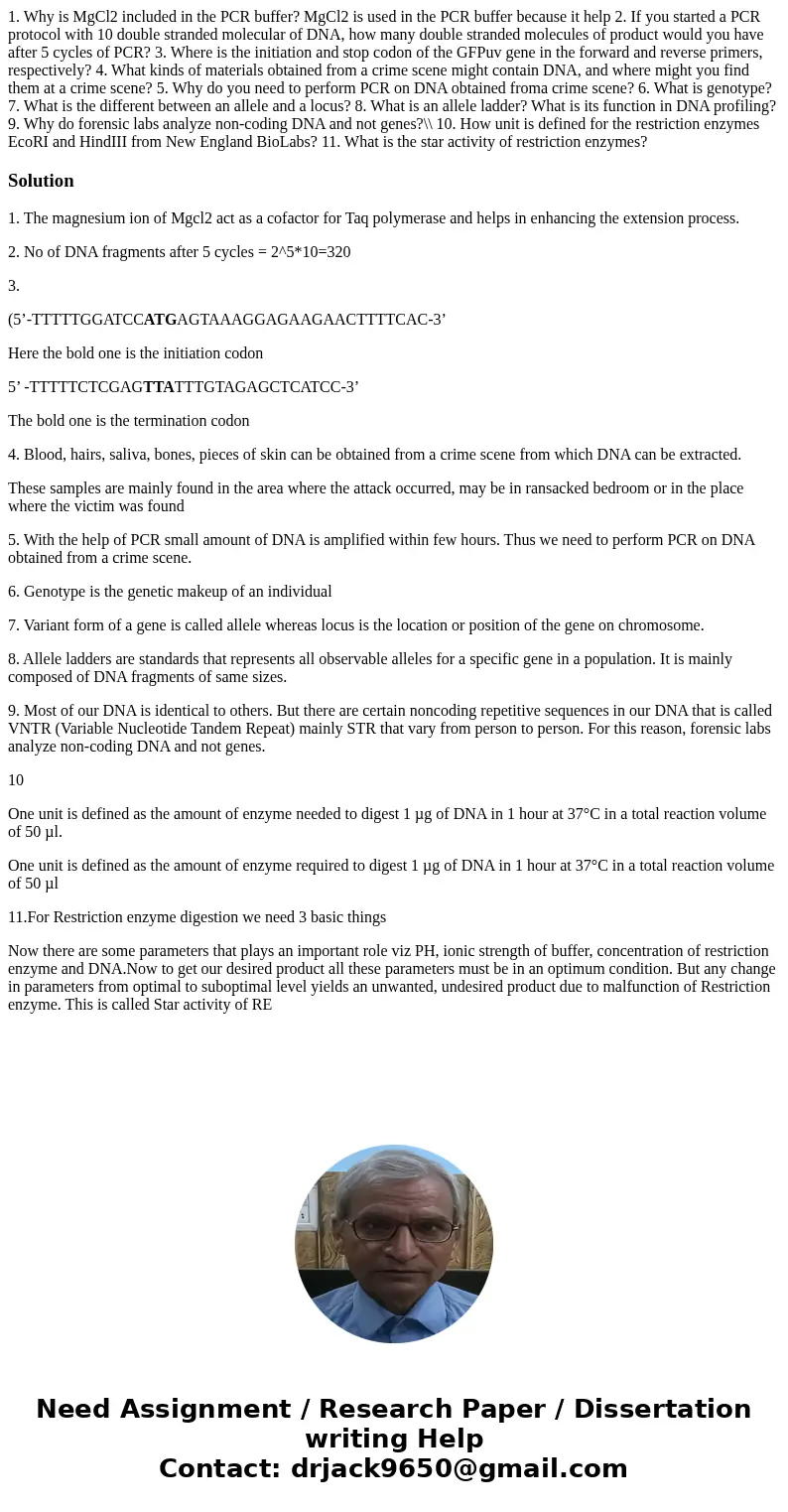1 Why is MgCl2 included in the PCR buffer MgCl2 is used in t
1. Why is MgCl2 included in the PCR buffer? MgCl2 is used in the PCR buffer because it help 2. If you started a PCR protocol with 10 double stranded molecular of DNA, how many double stranded molecules of product would you have after 5 cycles of PCR? 3. Where is the initiation and stop codon of the GFPuv gene in the forward and reverse primers, respectively? 4. What kinds of materials obtained from a crime scene might contain DNA, and where might you find them at a crime scene? 5. Why do you need to perform PCR on DNA obtained froma crime scene? 6. What is genotype? 7. What is the different between an allele and a locus? 8. What is an allele ladder? What is its function in DNA profiling? 9. Why do forensic labs analyze non-coding DNA and not genes?\\ 10. How unit is defined for the restriction enzymes EcoRI and HindIII from New England BioLabs? 11. What is the star activity of restriction enzymes?
Solution
1. The magnesium ion of Mgcl2 act as a cofactor for Taq polymerase and helps in enhancing the extension process.
2. No of DNA fragments after 5 cycles = 2^5*10=320
3.
(5’-TTTTTGGATCCATGAGTAAAGGAGAAGAACTTTTCAC-3’
Here the bold one is the initiation codon
5’ -TTTTTCTCGAGTTATTTGTAGAGCTCATCC-3’
The bold one is the termination codon
4. Blood, hairs, saliva, bones, pieces of skin can be obtained from a crime scene from which DNA can be extracted.
These samples are mainly found in the area where the attack occurred, may be in ransacked bedroom or in the place where the victim was found
5. With the help of PCR small amount of DNA is amplified within few hours. Thus we need to perform PCR on DNA obtained from a crime scene.
6. Genotype is the genetic makeup of an individual
7. Variant form of a gene is called allele whereas locus is the location or position of the gene on chromosome.
8. Allele ladders are standards that represents all observable alleles for a specific gene in a population. It is mainly composed of DNA fragments of same sizes.
9. Most of our DNA is identical to others. But there are certain noncoding repetitive sequences in our DNA that is called VNTR (Variable Nucleotide Tandem Repeat) mainly STR that vary from person to person. For this reason, forensic labs analyze non-coding DNA and not genes.
10
One unit is defined as the amount of enzyme needed to digest 1 µg of DNA in 1 hour at 37°C in a total reaction volume of 50 µl.
One unit is defined as the amount of enzyme required to digest 1 µg of DNA in 1 hour at 37°C in a total reaction volume of 50 µl
11.For Restriction enzyme digestion we need 3 basic things
Now there are some parameters that plays an important role viz PH, ionic strength of buffer, concentration of restriction enzyme and DNA.Now to get our desired product all these parameters must be in an optimum condition. But any change in parameters from optimal to suboptimal level yields an unwanted, undesired product due to malfunction of Restriction enzyme. This is called Star activity of RE

 Homework Sourse
Homework Sourse